Multiple Eco Print Effects

When things don’t quite turn out great; don’t ever despair and give up! Try to be even more creative, take it up a notch. Eco printing is not limited to one print; so many amazing effects are possible. I’ll show you how to take drab prints to ‘Fab’ prints!

The basic Eco Print:
It probably starts somewhat like this; damp dyed fabric (madder dyed in this case), leaves placed and then layered with an iron blanket, barrier layer (upcycled reused plastic). Tightly rolled, tied and processed (my favourite in microwave) and waiting with anticipation for an amazing result! It’s so exciting!
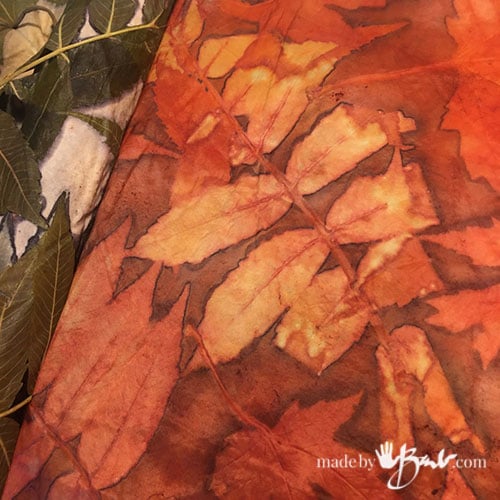
Oh wow! Unroll and see all the details and tones. When the prints are wet they tend to be darker and brighter. Washing will also sometimes take some of the contrasts away.
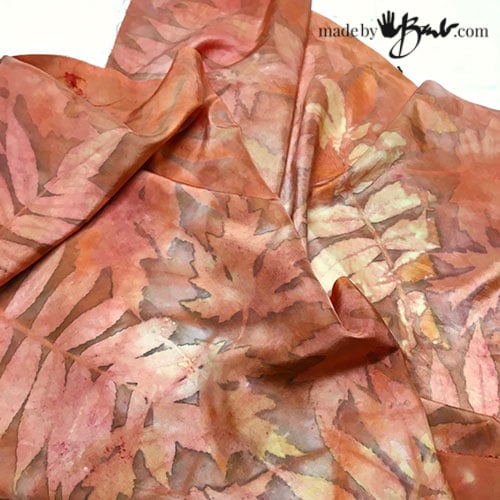
Everyone has their own taste and preferences. This would be totally acceptable and beautiful, but I like more defined details. That’s just how I am, even how I paint. I also tend to think there is always a way to improve designs… the curse of being a designer.

Eco Print Round #2:
So after washing and some contemplation I decided I did not have much to lose by trying another round of Eco printing. Out came the leaves and a simple use of and iron blanket again.
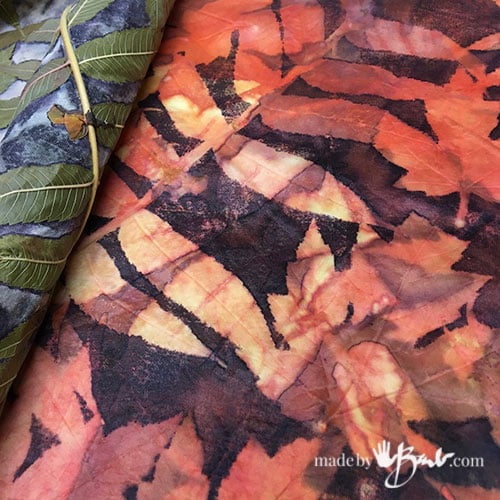
Tada!!! Well, much to my surprise many things seemed to happen inside that mysterious bundle! Can you see it!? The layering of shapes is interesting, since you can the silhouettes through the leaf shapes.
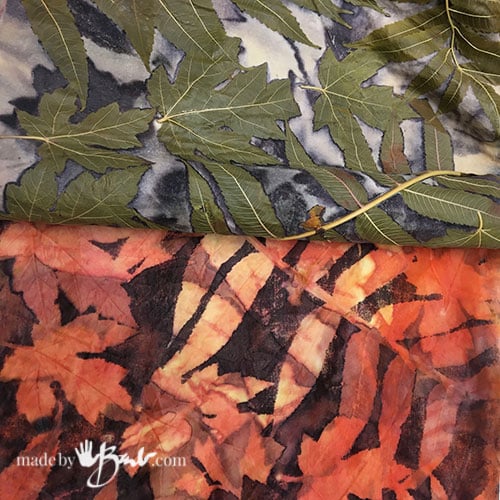
Even though the fabric was washed and dried and even sat for a while, it still possessed the ability to react with the ‘new’ tannins and ‘new’ iron blanket. Yes, I know it now has a lot of darks meaning there is quite a bit of iron which can degrade the fabric over time. I’d like to think I am making heirlooms but I’m much more in the ‘now’ than the +75 years!

Once I realized that multiple printing gives such new opportunities, out came some so-so prints for round #2!

Such amazing layering! And that does not even explore some additional options of dyes and tannin use. You just need to be aware that the iron and tannins in the first round are still able to take part in the reactions! For that reason I would avoid an entire dip in iron solution.

This print was an accidental shocker! See the wonderful fern prints?! These just happened to transfer from the prior use of the iron blanket. It only managed to transfer where the tannins of the maple leaves were. How novel?!
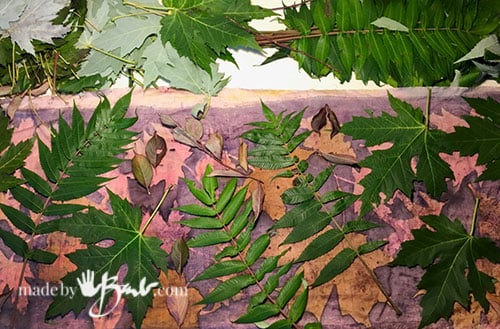
Once I figure out something new… I’m off and running! And Rolling! Some drapery silk (cochineal printed months earlier) was a bit too predictable!

So much better in my opinion! Look carefully and you will see the first maple leaf prints in this multiple eco print!
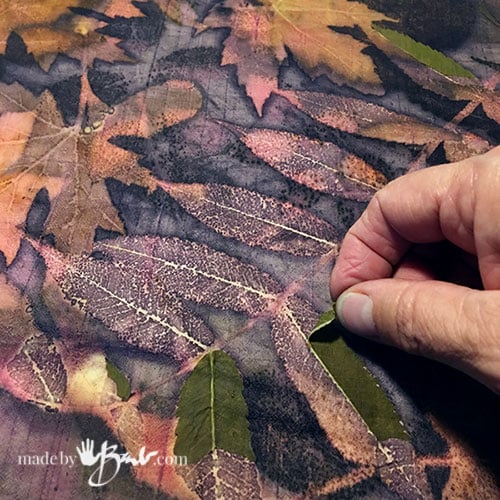
Can I say it again?! This is so much fun; even though it IS unpredictable!
So, do not just stash your dull prints! Give them new life! Try Multiple Eco Print effects! Let know what magic you make!
I am an ice dyer. I might dye the same piece 2 or 3 times. It is exciting isn’t it.
I love ice dyeing too! Especially when it ‘splits’ in to such great designs! Who knows… maybe these 2 will come together! All dyeing is fun!
Combining the two techniques. What a fine idea. Can you ice dye with silk and/or wool?
I don’t think so, only because the protein fibres require that you use an acid to make the dye into an acid dye (like vinegar) This did mimic the details of ice dyeing. I always say… where there’s a will! However maybe using a dye carrier blanket with the Eco printing!
You can dye silk with Procion mx dye in ice dyeing. I use silk all the time to make scarves and fabric. Scour the silk, use a soda ash soak and ice dye using your favourite method… ie with powder or liquid dye. Give it a go. The procion mx dyes don’t work on wool.
Be careful as Soda ash will hurt the protein fibres of silk. Just wash with a good soap. Use an acid like vinegar to make the dye act as an acid dye with silk and wool. True blacks are difficult to get on silk however. But it’s all fun and interesting!
These results are amazing. …amazingly beautiful. I can hardly wait to try this technique. It is magic
Well, maybe a bit of magic. I’m a great observer and designed with what I would see concrete do. Nature inspires me…
Hi Barb.
I have a question re: your multiple print above.
On the 2nd printing you said “don’t dip entirely in iron because there is aready iron from first print. How I’d that achieved exactly. . Do you leave out the 2nd iron blanket or maybe you only dip leaves in iron. Sorry to be so obtuse but want to try this method.
Many thanks
I do not dip the pre-printed fabric in iron. I do use an iron blanket (probably since it’s my favourite method) but it could also be interesting with just leaves dipped in iron! Or a combination! Hmmm, worth another try! Whatever happens… it’s magic!
have you tried to eco print these leaves in a cotton t-shirt?
if so, for how long they rest?
I mean, as you said, washing will remove the bright and color, but for sure T-shirts should be washed routinely.
And those printings are lovely, for special and unique T-shirts
I have printed on t-shirts and on cotton. I tend to like the control of printing first and then making something where I can plan the best parts of the prints. If you want brighter colours using some natural dyes like cochineal or logwood would help. I am just cautious about the laundry soap these days as they may too harsh for the dyes. PH matters much to these natural dyes. Myrobalan is also great and gives some nice colours. So much to try…
Do you have any videos or tutorials available for purchase?
At the moment I do not. I do share quite a bit on my site (under the ‘Home’ menu). I am hoping to offer an eBook in the future. Hope that helps!
Thanks for sharing so much information and inspiration and innovation!? I’ve been enjoying your site for a while but I suppose I’m going to have to try to imitate your precise method one of these days, because I’m still always astounded at the beautiful, rich, detailed, breathtaking results you constantly get with your eco-printing. While I have never tried incorporating natural dyes into the preparation phase, I’ve certainly not once ever gotten results anywhere like yours. Not even a tiny little bit. I’ve had some appealing arrangements of shapes and colors and whatnot, but really the prints usually appear like they could’ve been created by _anything _.
I really admire how busy you seem to be, how much you get done, what remarkable results, what incredible ideas, and thank you again for making it available to others as well.
Oh btw I noticed your comment about an ebook… I would undoubtedly pay a decent chunk of change for an ebook or a physical sort of instructional book you wrote, should it appear some day.
But oh my, if you had something more like Coffee table book, more there to look pretty I guess than not, well, you could certainly pull that off with just your existing content! And it would make a great gift, as I’m sure many of us with our common interests in crafts or dyeing or ecoprinting would be thrilled to give a beautiful coffee table eco printing book to someone in order to introduce them to this thing we love (and I my case, suck at!!)
Just saying. 🙂
. Take care, be safe and healthy and keep up the amazing work. 🙂
Leanne
Leanne: Thanks for taking such time to write. As I mention often, I am determined or actually stubborn! I have printed quite a bit… and you’d be surprised wha my first prints looked like. So don’t feel so bad. Its been a few years of printing… and if I could I’d be printing everyday! I think it’s actually addictive, since it’s like a lottery or gambling – sometimes you ‘win’. Thanks for the suggestion for books. Oh, how I wish I had more time. Being a maker in all senses means never a spare moment. Check back often in case I get a book out. Stay safe and healthy
Hello Barb…
I am very interested to try ecoprinting on Silk or coton . I frequently used ecoprint on papers to do cards, books and différents things.
I carrefully read yours indications for using the technics you described.
I am planning to use them soon but I have some problems with the “mordançage of the fabrics ,Silk or coton .
Could you please give me some précisions on mordançage ? Which produits , concentrations, durations…
Many thanks in advance, I am looking forward News from you.
Please excuse my so poor english, I am french!
Roberte
Ah, yes the mordanting issue. I hate to buy strange chemicals so I have used the soy method and home-made aluminum acetate. I am an artist though, not a chemist/scienist. For exact recipes I am afraid you will have to pay for the info as most will not share their hard-earned secrets for free. If you are willing to spend the time to do some tests with your particular water/iron/leaves/dyes you will get a sense pf what works for you as well. I hate to guarantee anything… Have fun! Check out all the eco print posts
Hi from Spain. How incredible is your work! i absolutely love your diferents techiques, thank you so much for share your experiences with us!!!
Olá Barb! Sou Brasileira infelizmente não falo inglês 😔. Me desculpe. Sou apaixonada pelos seus trabalhos são fantásticos, maravilhosos amo. Obrigada por compartilhar. Gostaria de saber se você não tem o curso online! Quero muito aprender. Agradeço seu retorno! Abraços Deus o abençoe grandemente sempre. 🙏
‘Hi Barb! I’m Brazilian, unfortunately, I don’t speak English 😔. Excuse me. I am in love with your works, they are fantastic, I love them. Thank you for sharing. I wonder if you don’t have the online course! I want so much learn. Thank you for your return! Hugs God bless you greatly always. 🙏’
Sorry, I don’t have an online course. The nature of this art form makes it a bit difficult to make an online course. I am working on an eBook however… Do check out all my eco printing posts, lots of resources there.
Dear Barb! Greetings from Hungary! I’m sorry I don’t speak English well. I found the eco print technique a couple of months ago, it’s magical, but many times it failed. I found it on your website a couple of days ago, and I’ve been reading it ever since. Thank you for sharing this much information with us, a huge help! Kriszta
I think you will get hooked! Have fun and don’t despair when things are not perfect right away!
I have been getting pretty successful results eco-printing and using iron blankets. That is until this week! I pre-mordanted 1/2 the silk scarves I wanted to dye with alum, and 1/2 with symplocos, a plant based alum as a test. I tried logwood extract and madder root dyes, using higher concentrations hoping to get more depth of color. I do not have PH test strips, so I added the elements I researched that would help achieve the results I wanted. Everything was so washed out and pale! Even after the post iron blanket steps. All this info. is to preclude my question, “Do you test or know your water PH, and do you alter it?” I just ordered some test strips. Thank you ahead of time for any insights you may have.
I looked up what my city water has and it wasn’t an issue with me. I have not used the extracts but they are quite concentrated as far as I know. I know that logwood can change colour according to PH but that would not explain the pale quality. Are you absolutely sure they are real silk? I bought some that said real silk and they were not. I’m not sure what you mean; ‘Even after the post iron blanket steps.’ If you can test a bit of iron solution brushed on a section to see if it darkens. I use logwood chips and they give me more colour than I expect, especially on silk. I’m intrigued…
First, we have well water, I am going to try and find the test we had done when we bought the house. It may have a good analysis. The scarves are from a trusted source that I have used before, so I will try again after my PH test strips are on hand. I will let you know, thank you for the quick response.